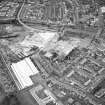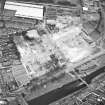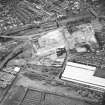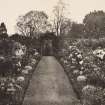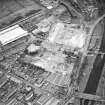Pricing Change
New pricing for orders of material from this site will come into place shortly. Charges for supply of digital images, digitisation on demand, prints and licensing will be altered.
Musselburgh, Old Bridge
Bridge (Medieval)
Site Name Musselburgh, Old Bridge
Classification Bridge (Medieval)
Alternative Name(s) River Esk; Roman Bridge; Old Bridge, Musselburgh
Canmore ID 53885
Site Number NT37SW 5
NGR NT 34076 72537
Datum OSGB36 - NGR
Permalink http://canmore.org.uk/site/53885
- Council East Lothian
- Parish Inveresk (East Lothian)
- Former Region Lothian
- Former District East Lothian
- Former County Midlothian
NT37SW 5.00 34076 72537
NT37SW 5.01 c. 3406 7254 gatehouse (possible)
For (successor) New Bridge (NT 34223 72642), see NT37SW 81.
(NT 3407 7254) Old Bridge (NR)
OS 6" map (1958)
Old Bridge [NR]
OS 1:10,000 map, 1989.
Old Bridge [NAT]
OS (GIS) AIB, April 2006.
NMRS REFERENCE
Non-Guardianship Sites Plan Collection, DC28380- DC28391, 1954 & 1956.
Architect: Believed to be originally of Roman workmanship. (3 arches 50 feet wide)
(Undated) information in NMRS.
Musselburgh Old Bridge, of 3 arches, with cut-waters, measuring 248' in length by c. 14' over the parapets. It may well have been built, as is traditionally said, by Jane, Lady Seton, who died in 1558. It may incorporate part of a stone bridge that was certainly standing in 1547, supposing this to have been subsequently damaged or destroyed, as might have occurred, for example, in 1548, when Musselburgh was burned by the English. Stirling records that during repairs in 1809, 'the face of one of the buttresses' was opened up and 'inside the outer building, remains of still older masonry resting on transverse oaken beams was found.'
An act was passed for the repair of a bridge at Musselburgh in 1597; it was again before parliament in 1625 and 1639, and repairs are mentioned frequently in Town Council records of the 17th century and later.
RCAHMS 1929, visited 1920; A Graham 1965.
As described.
Visited by OS (BS) 14 August 1975 .
The early 16th century Old Bridge [over the Esk] has three arches, refuges over the cutwaters, and stairs at each end.
C McWilliam 1978.
A watching brief was carried out during the excavation of an engineering trial pit over the centre arch of the medieval bridge. The pit showed that all old road surfaces had been removed and replaced with modern concrete and sand over the original stone bridge structure.
Sponsor: Jones Solas Partnership
M Collard 1992.
This bridge crosses the River Esk within the area of the town of Musselburgh (NT37SW 409). The location assigned to this record defines the centre of the structure, which apparently extends from NT c. 34064 72548 to NT c. 34097 72510.
Information from RCAHMS (RJCM), 26 April 2006.
Construction (1550 - 1559)
Possibly rebuilt by Lady Seton - previous bridge may have been destroyed when Musselburgh burnt in 1548. This bridge has similarities to Nungate Bridge at Haddington.
Field Visit (25 October 1920)
Musselburgh Bridge.
Towards the western end of the burgh, beside the station, the river Esk is crossed by a handsome stone bridge (Fig. 23 [SC1234622]), which in part is at least as early as the 16th century. The Esk at this point is about 150 feet in width and is spanned in two arches, while a third arch, out of alignment with the two first mentioned, carries the roadway over the low right bank of the river to the higher ground beyond; between the second and third arches there was a gate. The arches are segmental in form and have an average span of 51 feet; the width at soffit is 13 feet 4 inches. Between the arches are projecting cut-waters and the southern of these are carried up to parapet level to form refuges. The arch ring is in one course and is shielded by a projecting drip-stone; the masonry is of coursed rubble. The roadway is arched and is cobbled at the surface; the approaches being considerably lower than the roadway, the latter is now reached by steps at either end of the bridge; the traffic consequently is confined to pedestrians. Immediately above the bridge is a lord. The bridge is in good preservation.
HISTORICAL NOTE. The erection of the bridge is attributed by Nisbet to Jean or Janet, wife of the Lord Seton who fell at Flodden, and who herself died in 1558 (1). She carried out much building in the Collegiate Church of Seton (2).
In 1597 the Scottish Parliament passed an Act for the repairing of the bridge. The Town Council Minutes of 1687 refer to the ‘mid-bow’, so that the additional arch was then in existence, possibly as the result of the repair of 1597. In the same year and place there is a reference to ‘the bridgend doores’ (3).
RCAHMS 1929, visited 25 October 1920.
In Genealogy of the House, etc., of Setoun, by Sir Richard Maitland, edited by Chas. K. Sharpe, Edinb. 1830, p. x. Maitland, however, says nothing of the bridge; (2) See Inventory of Monuments in East Lothian, No. 191 ; (3) History of the Regality of Musselburgh, by James Paterson, p. 80.
Publication Account (1996)
The 'Roman' Bridge (also known as the Old Bridge) figures 7 &22.J is, in fact, medieval, possibly late medieval, but was probably erected on the site of an earlier Roman bridge that is known to have existed in this area. It was on the main route from the Roman camp at Inveresk to Cramond and, beyond, to the Antonine Wall. The medieval bridge continued to function as an important section of the main thoroughfare not only from east to west, but also as part of the primary route southwards. An earlier medieval bridge here may have been replaced in the early sixteenth century. What is clear from the records is that the bridge underwent constant renovation and repair, local people being stented to cover costs or drummed into forced labour (seep 31 & p 39). In 1296, the Scottish army passed over the bridge from Portobello to the battle of Dunbar; the retreating English crossed after their defeat at Bannockburn in 1314; it played a strategic role in the battle of Pinkie in 154 7 (see p 26); and it was a familiar landmark to Stewart kings, as well as to Mary of Guise, Mary Queen of Scots and the troops of the Young Pretender, Charles Edward Stewart. The bridge held an important significance for the people of Musselburgh, as it was on it that the town's west port, or gate, was sited, which delineated the limit of the town proper (see pp 29- 30). It is very probable that the first urban settlement at Musselburgh clustered around the bridge (seep 18). On the west side of the bridge there grew up the settlements of Bridgend and Fisherrow, both with close links to Musselburgh and within the burgh's liberties, but somewhat removed, both physically and psychologically (see p 26 & p 3-t). It is now somewhat altered from its medieval state: its easternmost arch, noticeably out of alignment with the other two, may have been added in 1597; and the bridge has steps at either end of its three spans, now used only by foot passengers.
The regular alterations and repairs to the bridge over the centuries have taken their toll. The potential for earlier phases of the bridge to be preserved within the more modern fabric was clearly demonstrated in 1809, when repair work to one of the buttresses revealed the masonry to be resting on older masonry, which, in turn, was supported by oaken beams. The oaken beams may well have been Roman. A recent archaeological watching brief, carried out during engineering works on the bridge, revealed that all the old road surfaces had been removed and replaced with modern concrete. This, unfortunately, means that the west port or gate to the burgh, which stood on the bridge itself, probably no longer survives.
Information from ‘Historic Musselburgh: The Archaeological Implications of Development’ (1996).
Watching Brief (March 2003 - May 2004)
A watching brief was undertaken between March 2003 and May 2004 on water mains renewal in the archaeologically sensitive areas of Musselburgh, Fisherrow and Inveresk. All pipe track digging was monitored and all excavations were recorded. A number of archaeological deposits were recorded in section and sampled. These included medieval and post-medieval midden deposits and features in Musselburgh and Fisherrow, and a buried soil horizon and a ditch on Inveresk Brae that probably relate to the nearby vicus of Inveresk Roman fort. A fragment of Samian ware and pieces of hypocaust tile were recovered from the ditch. In addition, a number of stone-built culverts and a section of the town mill lade were recorded.
Report to be lodged with East Lothian SMR and the NMRS.
Sponsor: Scottish Water.
M Kimber 2004
Project (2007)
This project was undertaken to input site information listed in 'Civil engineering heritage: Scotland - Lowlands and Borders' by R Paxton and J Shipway, 2007.
Publication Account (2007)
The historic Old Musselburgh Bridge is 248 ft long and bridging the Esk is generally 1112 ft wide between parapets, overall up to 14 ft wide. It has three segmental arches of about 51 ft span and 11 ft rise with hood-moulds and chamfered archstones and is built of large squared-rubble courses. Both piers are protected by large ‘whalebacks’ of masonry and concrete. A plausible speculation about the bridge’s origin is that an earlier stone bridge, which certainly existed, was damaged or destroyed when the English burned Musselburgh in 1548 and the present bridge was erected in the 1550s at the expense of Jane, Lady Seton. Its similarities with Nungate Bridge, Haddington, have already been noted. More than 150 years ago the original ramped approaches were replaced by the present steps which restricted the bridge to pedestrian use.
R Paxton and J Shipway 2007
Reproduced from 'Civil Engineering heritage: Scotland - Lowlands and Borders' with kind permission of Thomas Telford Publishers.





























